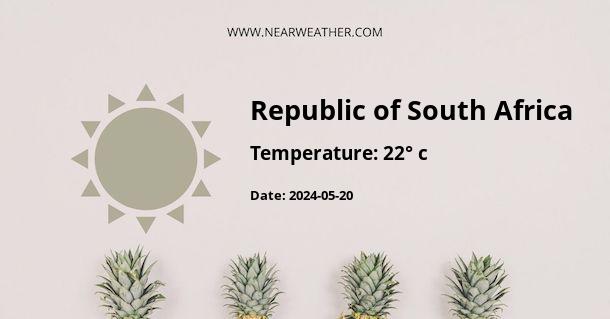Climate and Weather in the Republic of South Africa (ZA)
The Republic of South Africa, located at the southernmost tip of the African continent, experiences a diverse range of climates and weather conditions throughout the year. The country is known for its breathtaking landscapes, diverse wildlife, and vibrant cities. Understanding the climate and weather patterns of South Africa is essential for travelers, adventurers, and even locals. Let's explore the different climatic regions and seasonal variations in ZA.
Climatic Zones in South Africa
South Africa is characterized by a variety of climatic zones, ranging from arid deserts to Mediterranean-like coastal regions. These climatic zones are primarily influenced by factors such as latitude, altitude, ocean currents, and topography. Here are the four main climatic zones in South Africa:
- Subtropical Zone: Located along the northeastern coast, this zone experiences hot and humid summers with frequent afternoon thunderstorms. Winters are mild and dry, making it a popular destination for beachgoers and sun-seekers.
- Mediterranean Zone: Found along the southwestern coast, this zone has mild, wet winters and warm, dry summers. It is known for its scenic beauty and world-renowned wine regions.
- Desert Zone: The western and northwestern parts of South Africa fall into this zone, characterized by arid and semi-arid conditions. These regions experience very low rainfall throughout the year, with hot summers and cool winters.
- Highveld Zone: This zone covers the central plateau and is characterized by a moderate climate with warm summers and cold winters. It is also prone to afternoon thunderstorms during the summer months.
Seasonal Variations
The different climatic zones in South Africa result in distinct seasonal variations across the country. Understanding these variations is crucial for planning outdoor activities, safaris, and exploring the diverse landscapes of ZA. Let's take a closer look at the seasons in South Africa:
Summer (December to February)
During summer, most of South Africa experiences warm to hot temperatures. The northeastern and coastal regions are particularly hot and humid. Expect afternoon thunderstorms in the Subtropical Zone, providing relief from the heat. The Mediterranean Zone has warm and dry summers, making it an ideal time to explore the coastal areas. The Highveld Zone experiences afternoon thunderstorms, while the Desert Zone remains hot and dry.
Autumn (March to May)
Autumn in South Africa is generally mild and pleasant. The temperatures start to cool down, especially in the Highveld and Mediterranean Zones. This season is a great time to visit national parks and wildlife reserves as the weather is comfortable, and the landscapes come alive with vibrant colors.
Winter (June to August)
Winter in South Africa varies across the different climatic zones. The Subtropical Zone experiences mild winter temperatures, while the Mediterranean Zone has cool and wet winters. The Highveld Zone can get quite cold, with occasional snowfall in the higher regions. The Desert Zone remains dry and cool during winter, making it an attractive destination for those seeking warmer temperatures.
Spring (September to November)
Spring in South Africa brings a burst of new life and vibrant blooms. The temperatures start to rise, and the country is transformed into a colorful paradise. It is an excellent time to visit the national parks and botanical gardens. The Mediterranean Zone experiences comfortable temperatures, while the Desert Zone starts to warm up.
Extreme Weather Phenomena
South Africa, like any other country, is susceptible to extreme weather events. These events can range from heavy rainfall and flooding to severe droughts and heatwaves. It is essential to stay informed about any weather warnings or advisories when planning your visit. Here are a few notable extreme weather phenomena in South Africa:
Cyclones:
The eastern coastal regions of South Africa can be affected by tropical cyclones originating from the Indian Ocean. These cyclones bring heavy rainfall, strong winds, and can cause significant damage to infrastructure and property.
Droughts:
The arid and semi-arid regions of South Africa, particularly the Desert Zone, are prone to droughts. These prolonged periods of low rainfall can have a severe impact on agriculture, water resources, and the overall ecosystem.
Heatwaves:
During the summer months, South Africa can experience heatwaves, especially in the inland areas. These prolonged periods of extremely high temperatures can pose health risks and increase the risk of wildfires.
Conclusion
The Republic of South Africa offers a diverse range of climates and weather conditions throughout the year. From the hot and humid Subtropical Zone to the arid Desert Zone, each region has its own unique charm. Understanding the seasonal variations and extreme weather phenomena is crucial for planning your visit and ensuring a safe and enjoyable experience. Whether you're exploring the wildlife reserves, relaxing on the beautiful beaches, or immersing yourself in the vibrant city life, South Africa has something to offer for everyone.
A - Republic of South Africa's Latitude is -30.000000 & Longitude is 26.000000.
A - Weather in Republic of South Africa is 21° today.
A - Climate Conditions in Republic of South Africa shows clear sky today.
A - Humidity in Republic of South Africa is 53% today.
A - Wind speed in Republic of South Africa is 23.87 km/h, flowing at 336° wind direction. today.
